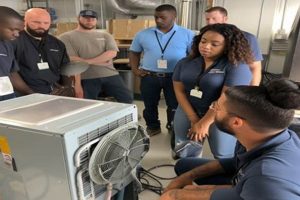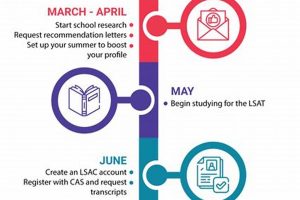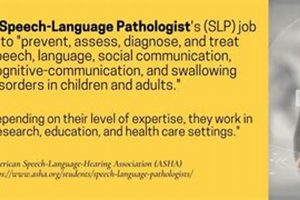Top-tier dental education programs in the United States represent a significant investment in future oral healthcare professionals. These institutions offer rigorous curricula, advanced clinical training, and research opportunities, producing graduates equipped to address complex dental needs and contribute to the advancement of the field. Examples include programs that emphasize specialized training in areas like periodontics, prosthodontics, and pediatric dentistry, often integrating cutting-edge technologies and research initiatives.
Access to high-quality dental education is essential for maintaining and improving public oral health. Graduates of leading programs are well-prepared to deliver comprehensive care, conduct impactful research, and shape policy decisions that influence the profession. Historically, these institutions have played a crucial role in developing innovative treatments, preventative strategies, and technologies that have transformed dental practice. Their continued excellence is vital for addressing emerging challenges in oral healthcare, such as the growing prevalence of chronic diseases and the need for accessible care in underserved communities.
This exploration delves deeper into various aspects of selecting and attending prominent dental education programs within the United States. Topics include admissions requirements, curriculum structure, faculty expertise, research opportunities, and career prospects. The following sections provide a comprehensive guide for prospective students seeking to pursue a career in dentistry.
Tips for Applying to Leading Dental Programs
Gaining admission to top dental schools requires careful planning and a strong application. The following tips offer guidance for prospective applicants.
Tip 1: Academic Excellence: Maintain a high GPA, particularly in science courses. A rigorous academic record demonstrates preparedness for the demands of dental school.
Tip 2: Dental Admission Test (DAT) Scores: Strive for competitive DAT scores. Dedicated preparation and practice tests are essential for achieving optimal performance.
Tip 3: Relevant Experience: Shadowing dentists, volunteering in dental clinics, or engaging in dental-related research demonstrates genuine interest and provides valuable experience.
Tip 4: Strong Letters of Recommendation: Cultivate relationships with professors and mentors who can provide compelling letters of recommendation highlighting academic abilities and character.
Tip 5: Well-Crafted Personal Statement: A thoughtful and compelling personal statement articulates motivations for pursuing dentistry and aligns personal goals with the program’s mission.
Tip 6: Research Program Specifics: Thoroughly research prospective programs, considering factors such as curriculum, faculty expertise, research opportunities, and clinical experiences.
Tip 7: Interview Preparation: Practice answering common interview questions to articulate experiences and goals effectively. Demonstrate professionalism and genuine enthusiasm.
By focusing on these key areas, applicants can significantly strengthen their candidacy and increase their chances of gaining admission to a leading dental program. A well-prepared application reflects dedication, commitment, and a genuine passion for the field of dentistry.
These tips provide a foundation for a successful application journey. The following section offers concluding thoughts and further resources for prospective dental students.
1. Accreditation
Accreditation serves as a critical benchmark of quality and rigor for dental education programs in the United States. For institutions aspiring to be recognized among the best, accreditation is not merely a formality but a fundamental indicator of their commitment to providing exceptional training and preparing graduates for successful careers in dentistry. Understanding the nuances of accreditation provides valuable insights into the landscape of dental education.
- Ensuring Educational Standards
Accreditation ensures that dental programs meet established standards for curriculum, faculty qualifications, clinical training, and research facilities. The Commission on Dental Accreditation (CODA), the primary accrediting body for dental programs in the US, sets these standards. For example, CODA guidelines stipulate specific clock hours of clinical practice required for graduation. Adherence to these standards ensures a consistent level of educational quality across accredited institutions.
- Protecting Student Interests
Accreditation safeguards student interests by ensuring programs provide the necessary resources and support for successful completion. This includes access to adequate library resources, well-equipped laboratories, and qualified faculty. Students attending accredited institutions can be confident that their education meets recognized quality standards, protecting their investment in their future careers.
- Impacting Licensure and Career Opportunities
Graduation from a CODA-accredited program is a prerequisite for licensure in most US states. Employers also often prioritize candidates who have graduated from accredited institutions. This underscores the significance of accreditation for career advancement and professional mobility.
- Promoting Continuous Improvement
The accreditation process involves ongoing self-assessment and external review, encouraging continuous improvement and innovation within dental education. This cyclical process ensures that programs remain current with advancements in the field and adapt their curricula to meet evolving needs in oral healthcare.
In the context of identifying leading dental schools in the US, accreditation serves as a critical filter. By focusing on accredited institutions, prospective students can narrow their search to programs that demonstrate a commitment to quality, rigor, and continuous improvement. This ultimately benefits the profession by ensuring a steady stream of highly qualified and competent dental professionals prepared to meet the evolving challenges of oral healthcare delivery.
2. Curriculum Rigor
Curriculum rigor serves as a defining characteristic of top-tier dental education programs in the United States. A demanding and comprehensive curriculum is essential for preparing graduates to navigate the complexities of modern dental practice and contribute meaningfully to the advancement of the field. The following facets illuminate the connection between curriculum rigor and leading dental schools.
- Foundational Sciences Integration
Leading dental programs emphasize a strong foundation in basic sciences, including biology, chemistry, and physics. This foundation is crucial for understanding the biological processes underlying oral health and disease. For instance, a deep understanding of microbiology is essential for diagnosing and treating infections, while knowledge of biochemistry is critical for understanding the effects of medications. Integration of these sciences throughout the curriculum ensures graduates possess the scientific literacy necessary for evidence-based practice.
- Advanced Clinical Training
Rigorous clinical training is a hallmark of top dental schools. Students gain extensive hands-on experience through rotations in various specialties, such as restorative dentistry, endodontics, and oral surgery. This immersive training, often conducted in state-of-the-art facilities, equips graduates with the practical skills and clinical judgment necessary to provide comprehensive patient care. Experiences may include treating patients with complex medical histories, managing emergencies, and working within interprofessional teams.
- Emphasis on Research and Innovation
Leading dental programs cultivate a culture of inquiry and innovation by integrating research opportunities into the curriculum. Students may participate in laboratory research, clinical trials, or public health projects, contributing to the advancement of dental knowledge and technology. This emphasis on research not only prepares graduates for academic careers but also fosters critical thinking and problem-solving skills essential for all dental professionals. For example, students may investigate the effectiveness of new materials or develop innovative diagnostic techniques.
- Focus on Interprofessional Collaboration
Recognizing the interconnectedness of healthcare disciplines, top dental schools increasingly emphasize interprofessional education. Students collaborate with medical, nursing, and pharmacy students, developing communication and teamwork skills essential for providing comprehensive patient-centered care. This collaborative approach prepares graduates to work effectively within interprofessional teams, improving patient outcomes and fostering a more integrated healthcare system.
These facets of curriculum rigor collectively contribute to the development of highly skilled and competent dental professionals. Leading dental schools prioritize a challenging and comprehensive curriculum, recognizing its crucial role in shaping future leaders in oral healthcare. This commitment to rigor ultimately benefits patients and the profession by ensuring a workforce prepared to address the evolving challenges of modern dental practice.
3. Faculty Expertise
Faculty expertise stands as a cornerstone of leading dental education programs in the United States. Distinguished faculty members bring a wealth of knowledge, experience, and innovation to the classroom and clinic, shaping the next generation of dental professionals. The quality and depth of faculty expertise directly influence the educational experience and contribute significantly to a program’s reputation and ranking.
- Distinguished Researchers and Scholars
Leading dental schools attract and retain faculty members who are recognized leaders in their respective fields of research. Their contributions to dental science through publications, presentations, and grant-funded research enhance the institution’s reputation and provide students with access to cutting-edge knowledge. For instance, a faculty member specializing in biomaterials research might involve students in developing innovative dental implants, providing invaluable hands-on experience and fostering a culture of scientific inquiry. This exposure to advanced research broadens students’ understanding of the field and prepares them to contribute to future advancements.
- Experienced Clinicians and Specialists
Top dental programs boast faculty members with extensive clinical experience across various dental specialties. This expertise translates into high-quality instruction in clinical settings, providing students with practical skills and mentorship from seasoned practitioners. A faculty member specializing in periodontics, for example, might guide students through complex periodontal procedures, offering personalized feedback and fostering clinical proficiency. This direct mentorship from experienced clinicians enhances the learning experience and prepares graduates for the demands of real-world practice.
- Dedicated Educators and Mentors
Beyond research and clinical practice, leading dental schools prioritize faculty members dedicated to teaching and mentoring. These individuals create engaging learning environments, foster critical thinking, and provide individualized support to students throughout their educational journey. A faculty advisor, for example, might guide students in selecting courses, exploring career paths, and navigating the challenges of dental school. This personalized mentorship contributes to student success and fosters a supportive learning community.
- Leaders in Organized Dentistry
Faculty members active in organized dentistry bring valuable insights into professional development, ethics, and advocacy. Their involvement in professional organizations, such as the American Dental Association (ADA), informs curriculum development and provides students with opportunities to engage with the broader dental community. This exposure to professional leadership prepares graduates to become active and informed members of the dental profession, contributing to its continued growth and advancement.
The collective expertise of the faculty significantly influences the quality and reputation of a dental school. Leading programs prioritize recruiting and retaining distinguished faculty members across various disciplines, recognizing their crucial role in shaping future leaders in oral healthcare. This commitment to faculty excellence enhances the educational experience, fosters innovation, and ultimately elevates the standards of dental practice.
4. Clinical Opportunities
Extensive and diverse clinical opportunities represent a hallmark of leading dental education programs in the United States. These opportunities bridge the gap between theoretical knowledge and practical application, shaping competent and compassionate dental professionals prepared for the complexities of patient care. The quality, breadth, and depth of clinical experiences directly correlate with a program’s ability to produce graduates equipped to excel in the field. A robust clinical program distinguishes top dental schools from their counterparts, contributing significantly to their reputation and rankings.
Clinical experiences at leading institutions often begin early in the curriculum, providing students with foundational skills and progressively increasing in complexity. Early exposure might involve observing experienced clinicians, assisting with basic procedures, and practicing on simulation models. As students progress, they assume greater responsibility, performing increasingly complex treatments under the supervision of faculty. For example, students might initially observe crown preparations and gradually progress to performing the procedure themselves under the guidance of a faculty member. Furthermore, advanced clinical rotations expose students to diverse patient populations and specialized areas like pediatric dentistry, oral surgery, and implant dentistry. Rotations at community clinics or hospitals, for instance, provide experience treating underserved populations and managing complex medical conditions, broadening students’ perspectives and preparing them to address healthcare disparities.
The integration of advanced technology and interprofessional collaboration further enhances the clinical experience at top dental schools. Students gain proficiency with cutting-edge diagnostic tools, such as digital radiography and cone-beam computed tomography, and utilize advanced treatment modalities like CAD/CAM technology and laser dentistry. This exposure to state-of-the-art technology prepares graduates to integrate these advancements into their future practices. Furthermore, interprofessional clinical experiences, often involving collaboration with medical, nursing, and pharmacy students, foster teamwork and communication skills essential for providing comprehensive patient-centered care. This collaborative approach reflects the evolving landscape of healthcare and equips graduates to work effectively within interdisciplinary teams. Ultimately, the richness and diversity of clinical opportunities available at leading dental schools play a pivotal role in shaping well-rounded, competent, and compassionate dental professionals prepared to meet the challenges and opportunities of modern dental practice.
5. Research Facilities
State-of-the-art research facilities are a defining characteristic of top dental schools in the United States. These facilities provide the infrastructure and resources necessary for groundbreaking discoveries and advancements in oral healthcare. A strong research component not only elevates the institution’s academic standing but also enriches the educational experience for students, fostering a culture of inquiry and innovation. The quality and accessibility of research facilities directly correlate with a program’s ability to attract top faculty and students, contributing significantly to its reputation and ranking.
- Advanced Laboratory Infrastructure
Leading dental schools invest heavily in sophisticated laboratory equipment and technologies. These resources might include advanced imaging systems, such as confocal microscopes and micro-CT scanners, as well as molecular biology laboratories equipped for genomic and proteomic analysis. Access to such advanced instrumentation allows researchers to explore complex biological processes at the cellular and molecular level, contributing to a deeper understanding of oral health and disease. For example, researchers might utilize these tools to investigate the mechanisms of tooth decay or develop novel biomaterials for regenerative dentistry.
- Dedicated Research Centers and Institutes
Many top dental schools house dedicated research centers and institutes focused on specific areas of oral health research. These centers might specialize in areas like craniofacial biology, biomaterials science, or oral cancer research. The focused research conducted within these centers fosters collaboration among faculty and students, accelerates scientific discovery, and translates research findings into clinical applications. For instance, a craniofacial biology research center might investigate genetic factors influencing cleft lip and palate, while a biomaterials science center could develop new dental implant materials. These specialized centers contribute significantly to the advancement of knowledge and innovation within the field.
- Opportunities for Student Involvement
Leading dental schools prioritize integrating research opportunities into the curriculum, providing students with valuable hands-on experience. Students might participate in ongoing research projects under the mentorship of faculty, conduct independent research as part of their coursework, or pursue summer research fellowships. This early exposure to research fosters critical thinking skills, encourages scientific inquiry, and prepares students for careers in academia or research-intensive clinical practice. For example, a student might assist with data collection and analysis in a clinical trial investigating a new treatment for periodontal disease, gaining valuable experience in research methodology and contributing to the advancement of dental knowledge.
- Collaboration and Funding Opportunities
Top dental schools actively seek collaborative research partnerships with other institutions, including medical schools, hospitals, and industry partners. These collaborations expand research capabilities, provide access to diverse expertise, and facilitate the translation of research discoveries into practical applications. Furthermore, leading programs often have strong track records of securing extramural research funding from government agencies and private foundations. This robust funding environment supports cutting-edge research initiatives and provides opportunities for students and faculty to engage in impactful research projects. For instance, a dental school might collaborate with a medical school on a research project investigating the link between oral health and systemic diseases, leveraging the expertise of both institutions to address a complex health issue.
The presence of robust research facilities distinguishes leading dental schools and significantly contributes to their academic prestige. These facilities not only support groundbreaking research but also enhance the educational experience, preparing graduates to become leaders in the field. The commitment to research and innovation ultimately benefits the profession by driving advancements in oral healthcare and improving patient outcomes. By fostering a culture of inquiry and providing access to state-of-the-art resources, top dental schools cultivate the next generation of dental researchers and clinicians, ensuring the continued progress and evolution of the field.
6. Location and Cost
Location and cost are significant factors influencing the pursuit of dental education at leading US institutions. Geographic location impacts access to specific patient populations, specialized clinical experiences, and networking opportunities. For example, urban settings may offer greater exposure to diverse patient demographics and specialized care facilities, while rural locations may provide experience in addressing healthcare access disparities. Furthermore, proximity to major research institutions or industry partners can create opportunities for collaborative research and career development. Cost considerations encompass tuition, fees, living expenses, and potential scholarship opportunities. The financial investment required to attend top dental schools can vary considerably based on the institution’s public or private status, resident or non-resident status, and availability of financial aid. For instance, attending a private institution in a high-cost-of-living area may require substantially greater financial resources than attending a public, in-state institution. These financial considerations necessitate careful planning and exploration of funding options, including scholarships, loans, and grants.
The interplay between location and cost influences career trajectory and long-term financial well-being. Graduates of prestigious programs located in high-demand areas may have greater earning potential and access to diverse career paths. However, higher educational costs can lead to increased debt burden, impacting financial decisions early in one’s career. Therefore, prospective students must carefully weigh the long-term implications of location and cost when selecting a dental program. A strategic approach involves assessing personal financial resources, evaluating potential career opportunities in different geographic regions, and considering the return on investment of various programs. For instance, a graduate with a strong interest in public health dentistry might prioritize programs located in areas with significant underserved populations, even if it entails higher living costs or lower immediate earning potential.
In summary, location and cost are integral considerations in the pursuit of dental education at top US institutions. Geographic location influences clinical experiences, networking opportunities, and career prospects, while cost considerations require meticulous financial planning. A balanced assessment of these factors, alongside program quality and personal aspirations, empowers prospective students to make informed decisions aligning with their long-term professional and financial goals. Understanding the interplay between these factors contributes to a more comprehensive and nuanced understanding of the landscape of dental education in the United States.
7. Alumni Network
A robust and engaged alumni network represents a significant advantage for graduates of leading dental schools in the United States. These networks provide invaluable support, mentorship, and career development opportunities, contributing significantly to professional success and lifelong learning. The strength and reach of an alumni network often correlate with a program’s prestige and reputation, reflecting the institution’s commitment to fostering a vibrant and supportive community of dental professionals.
- Mentorship and Guidance
Alumni networks facilitate mentorship programs connecting recent graduates with established professionals in various specialties and practice settings. This mentorship provides guidance on career choices, practice management, and professional development. For example, a recent graduate interested in specializing in prosthodontics might connect with an alumnus practicing in that specialty for advice and guidance on navigating the specialization process. This personalized mentorship can significantly impact career trajectory and professional growth.
- Career Networking and Job Opportunities
Alumni networks often serve as valuable platforms for career networking and job placement. Alumni frequently share job openings within their practices or organizations, providing graduates with access to exclusive opportunities. Alumni events and online platforms facilitate connections between graduates seeking employment and established professionals seeking to expand their teams. For instance, an alumnus seeking an associate dentist for their practice might post the opportunity on the alumni network platform, providing graduates with a direct connection to a potential employer. This streamlined access to job opportunities can significantly shorten the job search process and facilitate career advancement.
- Continuing Education and Professional Development
Leading dental schools often leverage their alumni networks to provide continuing education and professional development opportunities. Alumni may serve as guest lecturers, lead workshops, or participate in online forums, sharing their expertise and keeping graduates abreast of the latest advancements in the field. For example, an alumnus specializing in implant dentistry might present a webinar on new implant techniques, providing graduates with valuable continuing education credits and enhancing their clinical skills. This ongoing access to professional development resources contributes to lifelong learning and career advancement.
- Philanthropic Support and Institutional Advancement
Engaged alumni networks often contribute significantly to the philanthropic support and advancement of their alma maters. Alumni donations support scholarships, research initiatives, and facility upgrades, enhancing the educational experience for future generations of dental professionals. For instance, alumni donations might fund a state-of-the-art simulation laboratory, providing students with advanced training opportunities and contributing to the program’s overall excellence. This philanthropic support strengthens the institution and ensures its continued success in preparing future leaders in the field.
A strong alumni network serves as a valuable asset for both graduates and the dental school itself. For graduates of leading US dental schools, these networks offer invaluable support, mentorship, and career development opportunities, fostering lifelong learning and professional success. For the institutions, a robust alumni network reflects the program’s quality and reputation, attracting prospective students and enhancing its standing within the dental community. The mutually beneficial relationship between alumni and their alma maters strengthens the profession as a whole, fostering a community of dedicated professionals committed to advancing oral healthcare.
Frequently Asked Questions about Top Dental Programs
This section addresses common inquiries regarding admission to and attendance at leading dental schools in the United States. Understanding these frequently asked questions can assist prospective students in navigating the application process and making informed decisions about their dental education.
Question 1: What are the typical admissions requirements for top dental programs?
Competitive applicants generally possess a strong academic record, particularly in science coursework. High scores on the Dental Admission Test (DAT) are essential. Relevant experience, such as shadowing dentists or volunteering in dental clinics, strengthens applications. Strong letters of recommendation and a compelling personal statement are also crucial components.
Question 2: How does one choose the right dental program?
Factors to consider include program accreditation, curriculum rigor, faculty expertise, available research opportunities, clinical experiences, location, cost, and alumni network strength. Aligning personal career goals with program strengths is paramount.
Question 3: What is the significance of program accreditation?
Accreditation by the Commission on Dental Accreditation (CODA) signifies adherence to national standards for curriculum, faculty, and facilities. Accreditation is often a prerequisite for licensure and impacts career opportunities.
Question 4: How can one finance dental education?
Options include scholarships, grants, loans, and personal savings. Thorough research into available funding opportunities and careful financial planning are crucial.
Question 5: What career paths are available to dental school graduates?
Graduates can pursue careers in private practice, academia, research, public health, and various specialized fields within dentistry. The chosen program’s focus and available resources can influence career trajectory.
Question 6: How important is research experience during dental school?
While not always mandatory, research experience can enhance a graduate’s competitiveness for specialized training programs and academic positions. It also fosters critical thinking and problem-solving skills valuable in any dental career.
Careful consideration of these frequently asked questions assists prospective students in making informed decisions about pursuing dental education at leading US institutions. A clear understanding of the application process, program characteristics, and career pathways contributes to a successful and fulfilling dental career.
The concluding section offers final thoughts and additional resources for prospective dental students.
Pursuing Excellence in Dental Education
This exploration has provided a comprehensive overview of factors defining top-tier dental education programs in the United States. Key considerations include rigorous curricula, distinguished faculty expertise, state-of-the-art research facilities, extensive clinical opportunities, and the strength of alumni networks. Furthermore, location and cost considerations play a significant role in the decision-making process for prospective students. Accreditation by recognized bodies ensures adherence to quality standards and impacts career prospects. Understanding these factors empowers aspiring dental professionals to make informed choices aligning with individual career aspirations and long-term goals.
The pursuit of excellence in dental education requires dedication, perseverance, and a commitment to lifelong learning. As oral healthcare evolves, the demand for highly skilled and compassionate dental professionals continues to grow. By selecting a program that prioritizes academic rigor, clinical proficiency, and research innovation, aspiring dentists invest not only in their own futures but also in the future of oral healthcare. The commitment to pursuing excellence in dental education ultimately benefits patients, advances the profession, and contributes to a healthier society.







